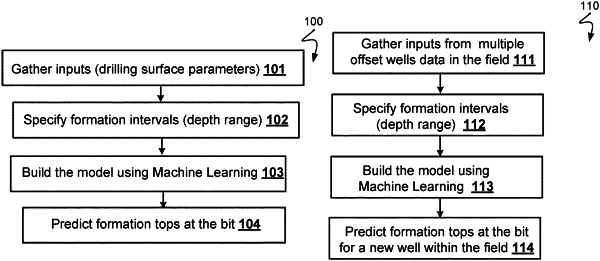| CPC E21B 44/00 (2013.01) [G01V 99/005 (2013.01); G06F 17/15 (2013.01); G06F 17/18 (2013.01); G06N 20/00 (2019.01); E21B 2200/20 (2020.05); E21B 2200/22 (2020.05)] | 17 Claims |

|
1. A computer-implemented method comprising:
accessing measurement data obtained from surface measurements and downhole sensors during past drilling operations, wherein the measurement data show multiple measurements taken during the past drilling operations when a drilling bit is located at a range of depths;
based on the measurement data obtained from the surface measurements, using machine learning analytics to construct a model that predicts a formation top when the drilling bit reaches a depth within the range of depths, wherein the model is calibrated by the measurement data obtained from downhole sensors located above the drilling bit during the past drilling operations;
determining a correlation between the measurement data and the predicted formation top by:
determining a covariance matrix between the measurement data and the predicted formation top; and
calculating the correlation based on the covariance matrix; and
in response to determining that the correlation exceeds a pre-determined threshold, applying the model to predict a formation top during a later drilling operation such that, based on applying the model to measurement data from surface measurements during the later drilling operation and without using measurement data from downhole sensors, an alarm is provided to an operator when the drilling bit is entering a new formation top after passing the depth.
|